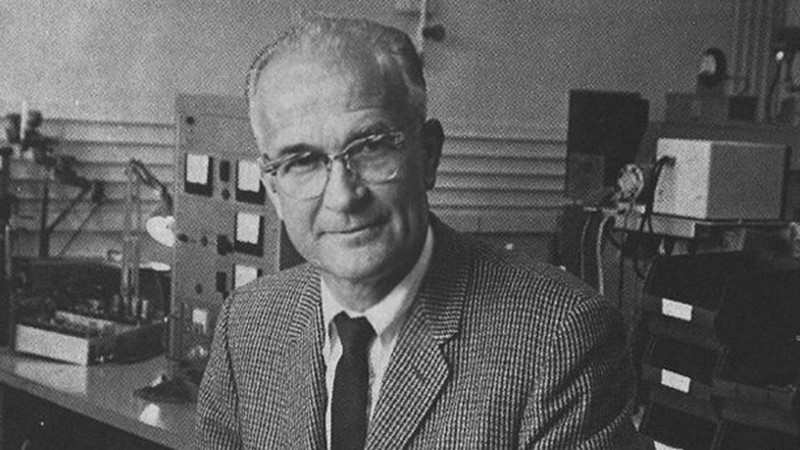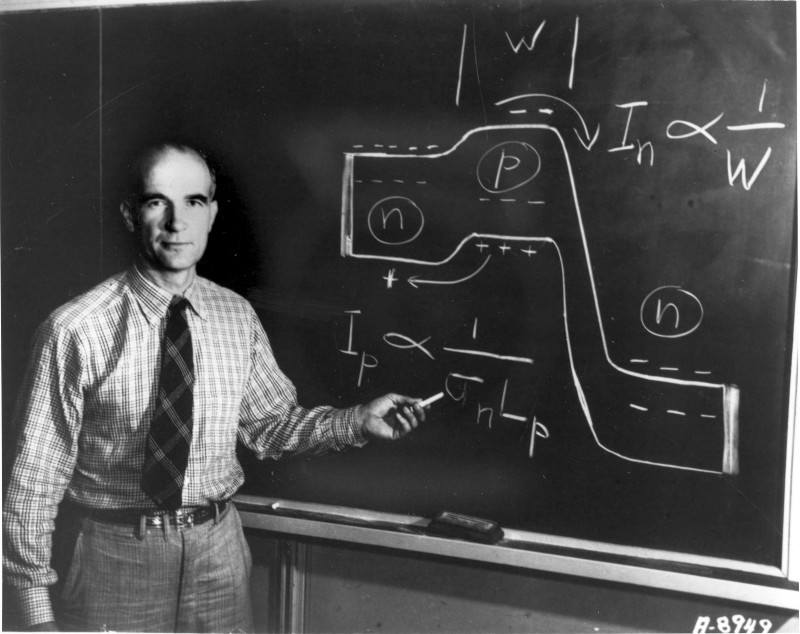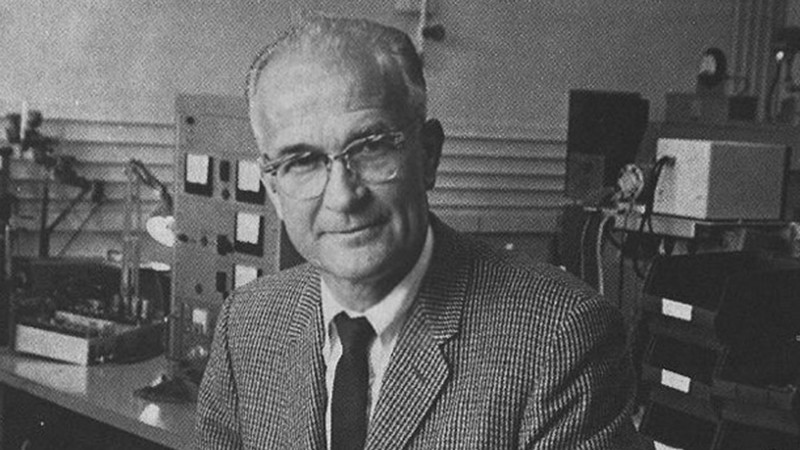by Mark Mann
Silicon Valley’s Smartest Loser

Behind every success story is a missed opportunity. For every entrepreneur who does something great, there’s someone else who had the chance and didn’t take it. Silicon Valley was built on one such lost cause, and his name was William Shockley.
Before the Valley’s namesake metalloid became the material of choice for integrated circuits, physicists were using a less-reactive substance called germanium to build semiconductors. Shockley was one of them, and he had the smart idea to use silicon instead.
Shockley had won a Nobel Prize in 1956 for contributing to the invention of transistors. Compared to the electron vacuum tube that it replaced, the transistor is a smaller, cheaper, and more efficient way of controlling the flow of electricity on a circuit board. Though other scientists played greater roles in key aspects of the invention, Shockley led the group and refined the design. The ensuing notoriety earned him the financial backing he needed to start his own company, Shockley Semiconductor Laboratory, where he aimed to build silicon transistors to replace the germanium ones that were already being used in many devices. He was able to leverage his scientific stardom to attract eight extremely talented physicists and engineers to help him do it, including Robert Noyce and Gordon Moore, who would later found Intel.

Everyone on the team was a genius in his own right, but none of them actually knew how to build transistors when they arrived at Shockley’s lab. So they started holding study sessions to teach each other semiconductor theory. The group quickly discovered that they enjoyed working together and were attracted to the challenge of commercializing silicon semiconductors.
Shockley, meanwhile, was losing interest in silicon transistors. He wanted to find the next big breakthrough and maintain his reputation as a premiere scientist, not waste time refining existing technology. His employees recognized the commercial potential of what they were doing, however, and they were eager to make the shift from research scientists to production engineers.
Shockley made the same mistake that startup founders often do: he equated innovation and entrepreneurship. “He thought that by just doing good science, you are bound to have a profitable company,” said Hans Quiesser, one of the original team members. Shockley’s employees were laying the groundwork for arguably the most important invention of the 20th century — the microchip — but he lacked the commitment and focus to nurture their work and commercialize the technology. Rather than invest the time to make silicon transistors reliable for mass-production, Shockley wanted something new.
The tension between Shockley and his team went beyond conflicting ambitions, however. Shockley treated his fellow physicists like lackeys, not partners. The dominant business culture at the time was strictly hierarchical, and Shockley ran his lab like a paranoid tyrant. When a woman on staff was pricked with a pin while opening a door, Shockley became convinced that someone had left it there maliciously. He started forcing his employees to take lie-detector tests, until as a group they refused.
Predictably, Shockley’s relationship with his team disintegrated, and the group started looking elsewhere for work. At the time, there was no such thing as startup culture, nor any venture capital to support it. But even though they had no product and no managerial experience, and had conducted no formal market research, the eight team members knew they wanted to stick together, so they decided to start their own company.
Eventually, they contacted a New York-based company called Fairchild Camera and Equipment, and set up their own subsidiary company among the fields and farms of what was then called the Valley of Heart’s Delight, only a mile and half down the road from Shockley’s lab. They called it Fairchild Semiconductor, but Shockley dubbed them “the Traitorous Eight.”

Though his loyalty to Shockley delayed him from joining the others by a few months, Noyce emerged as the leader of the group. Noyce was at least Shockley’s equal in inventiveness, but his opposite in temperament. As much as Shockley was “competitive and controversial,” as Moore described him, Noyce was charming and personable. He rejected Shockley’s top-down leadership style, and encouraged everyone to share their ideas and work collaboratively.
The group figured out how to mass-produce silicon transistors and sold their first batch to IBM, but the transformative moment came when Noyce had the idea to print full circuit boards on a single wafer of silicon. Essentially, he took something that was three-dimensional and made it two-dimensional. Another scientist named Jack Kilby had also developed the idea for integrated circuits a few months before, but he was using germanium, not silicon. Noyce’s version was more efficient and more reliable, and he had the right people around him to make it a viable product. Thus, the microchip was born.
The group faced many challenges bringing microchips to market. They had to learn how to grow silicon crystals, turn diffusion from a dangerous process to a stable one, and build stop-and-repeat cameras for applying transistors and other semiconductor devices to the wafers. But what most helped them succeed was the invention of the planar process. The technique allowed the company to build many chips on a single board, which enabled them to produce higher volumes with lower margins and ultimately win the market.
Fairchild was profitable within six months of its founding. In three years, the company’s annual revenues were over $20 million. And within a decade, when they’d invented the integrated circuit, Fairchild’s annual sales were $90 million. The company also established a pattern of proliferation that would become a hallmark of Silicon Valley culture. Within twelve years, Fairchild employees had founded more than thirty new companies. Today, around seventy percent of publicly traded companies in the Bay Area trace their origins directly to Fairchild Semiconductor, and over four hundred companies have roots in the Traitorous Eight. It’s estimated that the total value of all these offshoots is over a trillion dollars.
Shockley Semiconductor didn’t survive the loss of its best employees, however. Within several months of their departure, Shockley shut down the firm. He spent the rest of his career teaching at Stanford.
Shockley’s problem wasn’t intellectual. (At least, not at first; in later life, he became obsessed with eugenics and racist theories of evolution.) In fact, those who worked with him held his genius in awe. Jay Last, another member of the original team, said that Shockley could “see electrons.” Moore said that Shockley possessed an incredible “physical intuition.” But genius doesn’t count for much if you ignore all the other geniuses around you. Fairchild Semiconductor succeeded where Shockley Semiconductor failed — along with all the other semiconductor companies in the valley that also failed or limped along with marginal products — because Noyce encouraged everyone to contribute, and treated all their ideas equally.
Unfortunately, Fairchild’s New York-based parent company failed to learn anything from Noyce, and the group rebelled once more against a top-down management style that they felt hurt their ability to commercialize new products. But this time they didn’t leave all together at the same time. One by one they trickled away to start their own companies, including Noyce, who founded Intel with Moore. There, he facilitated the invention of the microprocessor by Ted Hoff, proving again: no matter how smart you are, listen to the other smart people around you. It pays to help everyone succeed.
This article first appeared on Site Builder Report with the title The Genius Who Missed Silicon Valley’s Biggest Breakthrough.
